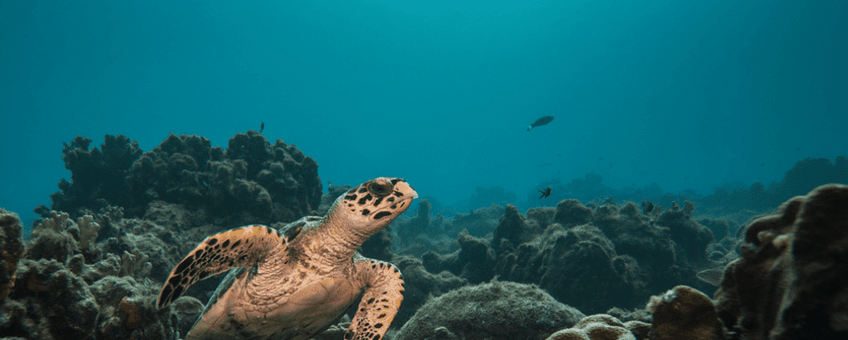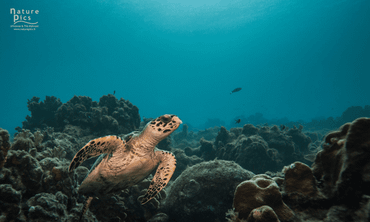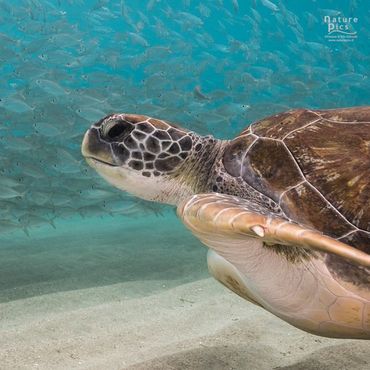
Three different types of turtles can be found on the beaches and in the surrounding waters of St. Eustatius: the hawksbill turtle (Eretmochelys imbricata), green turtle (Chelonia mydas) and leatherback turtle (Dermochelys coriacea). The hawksbill and green turtle are frequent visitors of the waters of St. Eustatius and can be encountered during snorkeling or diving. Every year, nesting hawksbill and green turtles can be found on the beaches as well. A less frequent visitor is the leatherback turtle. It can only be spotted while nesting, because the leatherback is a deep-sea species. Occasionally, leatherback turtle nests can be found on St. Eustatius.
Monitoring

STENAPA monitors the beaches, both in the morning and at night, to identify new nests and track hatching success. The details and information from these beach patrols are collected by filling in data sheets. Those data sheets can be used internationally to be able to compare the data. Annemieke Borsch and Louise Kramár, two students from Van Hall Larenstein University of Applied Sciences, recently produced protocols as part of an explanatory report in cooperation and guidance from STENAPA. These protocols cover morning patrol, night patrol and nest excavation while the whole report can be used as a guide on how to perform certain tasks in a correct, safe and careful way during patrols.
Importance of data collection
Data collection on turtles is important because it provides information on the status of the species. Baseline information can become important when a new factor comes into play, to see what the effect of the factor is. Aditionally, the data collection gives insight in the population trends, like whether the population is declining or growing. It makes it possible to detect diseases or parasites in a population in an early state as well. The data collection is also important to get to know the species better, for example their habitat, food source and breeding grounds, to protect these necessary factors for the turtles.
Why turtles need protection

The green, hawksbill and leatherback turtles are on the IUCN red list of endangered species. The green turtle is listed as ‘endangered’ and the hawksbill and leatherback turtles are listed as ‘critically endangered’. Sea turtles need protection because they are keystone species. This means that they are an important part of the marine environment and have an influence on the species living amongst them. Hawksbill turtles live close to coral reefs, where they feed on sponges that compete with corals for space. Green turtles are important because they feed on seagrass, which keeps the seagrass ecosystem healthy. Healthy seagrass ecosystems can store more carbon and sustain more species. Leatherback turtles are known to control the number of jellyfish in the oceans. Next to the ecological benefits, the turtles are important for coastal communities, as many people rely on the incomes that are being provided by turtle watching and diving. Some indigenous communities see turtles as a part of their culture and it has been said that seeing a turtle in the wild has psychological and emotional benefits.
How to support
There are several ways to contribute to the conservation of sea turtles on St. Eustatius. If you are interested in helping, STENAPA offers both part-time and full-time volunteering programs. For more information, contact volunteer@statiapark.org and/or check out statiapark.org/vacancies-turtle-program. Together with the National Parks Staff you can take part in the in-water surveys conducted throughout the Marine Park. If scuba diving is not possible, staff are happy to provide training for beach patrols so that you would be able to assist in the monitoring of nesting turtles on the beaches. The turtles are protected, so people are not allowed to disturb them. Therefore you should contact STENAPA if you want to be involved and not go looking for turtles by yourself.
STENAPA needs volunteers especially for the patrols, since it needs to be done a few times a week during nesting season. Their wish is for the (local) volunteers to be able to patrol as independently as possible with the help from instructions and the protocols guiding them.
More information
To learn more about STENAPA and the turtle species on St. Eustatius, you can visit statiapark.org. If you are interested in protocols about morning and night patrols and the nest excavations, send your request to STENAPA.
Text: DCNA and STENAPA St. Eustatius
Photos: Y.+T. Kühnast, Naturepics
